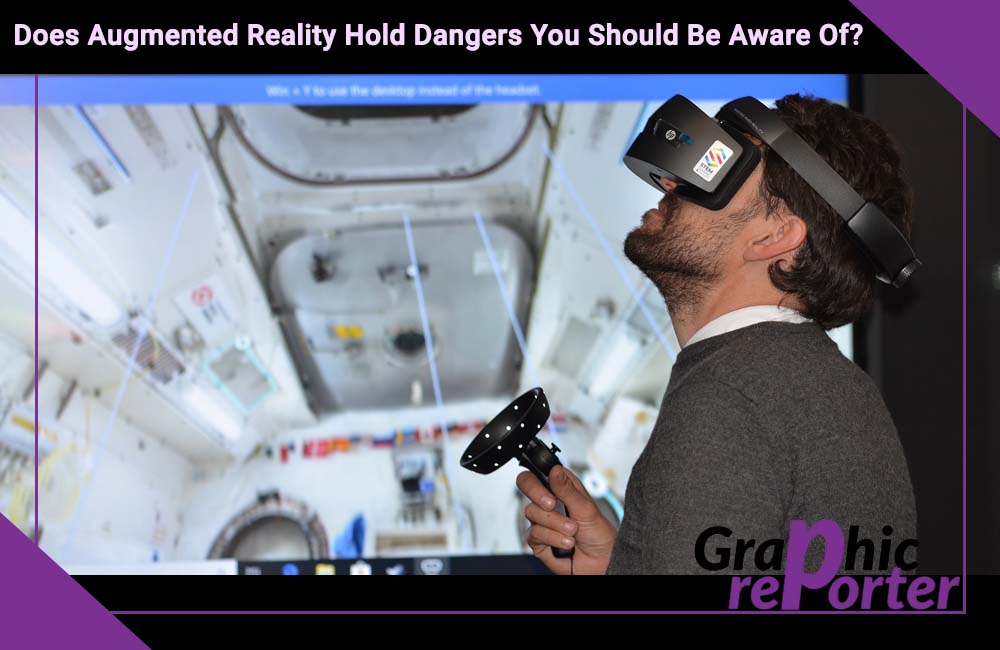Does Augmented Reality Hold Dangers You Should Be Aware Of?

Along with AI and electric vehicles, augmented reality or AR is a technology that’s about to go from buzzword to game-changer. Soon, it will transform the way we approach learning, shopping, entertainment, work, and more.
While it holds exceptional promise, AR also introduces new challenges its developers and society as a whole will need to tackle. How will AR benefit us, and which dangers can we expect from it? Take a tour & find out.
Table Of Contents
What Is AR & How Can We Benefit From It?
Augmented reality is a type of technology that overlays inputs from the real world with visual, aural, and other sensorial data. Let’s say you’re admiring a masterpiece at a museum. The info plaque next to it can tell you only so much. However, installing the right app and looking at the piece through your smartphone can reveal much more via engaging visuals and audio.
AR made a global splash in 2016 with the launch of Pokémon GO. The game prompted millions of trainers to go out & explore their surroundings while hunting for rare monsters. While it was ultimately a fad, the game demonstrated AR’s transformative potential.
The technology has been expanding and evolving since. The AR market was worth around $40 billion in 2023. Optimistic forecasts predict its worth will skyrocket to 1.2 trillion by 2032 as the technology and devices capable of running it mature.
Gaming and retail are leading the AR charge. For example, some furniture stores already use AR to help visualize what their models would look like in your living space. Widespread use of AR to examine products or try clothing on in virtual fitting rooms is also nearly here.
Augmented reality will surely become a cornerstone tool for medicine and education, too. It will offer guidance and directions to ensure work, play, or navigation happens more organically.
What Are the Dangers of AR?
As exciting as AR’s prospects seem, we shouldn’t neglect the pitfalls. As the technology is still new, it’s impossible to predict all its far-reaching consequences. However, some issues are already evident.
Privacy & security concerns
Reliance on a large amount of identifiable data is AR’s main drawback. It can’t operate unless it collects information on your surroundings and behavior, which an AR program/app’s owners need to store and process. Who’s to say they are using strong cybersecurity practices to keep you and your sensitive data secure?
The dangers are twofold. On the one hand, hackers could exploit vulnerabilities inside an AR program’s code to feed you misinformation. It could be something as insidious as planting misinformation in landmark descriptions or as dangerous as feeding false directions to a guidance system.
On the other hand, the crooks could gain access to information you store locally and wreak havoc with it. Like ordinary ones, AR apps will likely require a login.
The problem is that many people won’t even bother doing the bare minimum for their online security. This can be as simple as coming up with a strong and unique password for yet another account. With so many encrypted password managers out there, helping people store robust passcodes, this shouldn’t even be difficult to set up.
Unfortunately, it’s still not such a common practice. For thieves, stealing one set of credentials could then compromise countless other accounts, including ones that could give them access to banking details or sensitive medical information.
Ransomware could take on a new dimension. Cybercriminals could record embarrassing or compromising AR activities and threaten to leak the footage if victims don’t cooperate. Worse yet, they could shut down vital functions someone could rely on to do their work or get around, forcing them to pay to be able to live normally again.
Addiction
AR blurs the line between the actual world and a digital one we might want to live in more. The technology’s highly immersive nature makes it harder for developing minds to distinguish between the two. Therefore, it’s especially a threat to children and teens. Adults aren’t immune either, but their experiences & obligations may help curb AR’s addictive potential.
Devotedly chasing digital accomplishments leaves less time to work on real ones. Everything from one’s ability to concentrate, learn, maintain social relationships, and feel fulfillment in the real world suffers.
Other health factors
Even if they have a handle on their AR use, people can still experience side effects. The most common ones include eye strain, fatigue, and disorientation.
Risky Behavior
Blindly relying on AI can get users into sticky situations. There have already been numerous trespassing reports. Also, it’s sadly only a matter of time before someone loses their life due to disregarding their safety while engaging in AR activities.






